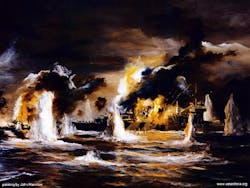Who sees and shoots first wins; Navy demonstrates lesson with surveillance and laser weapons
Navy leaders apparently are taking this maxim to heart in light of emerging hostile new maritime tactics in the Persian Gulf with reconnaissance technologies that presumably could give U.S. and allied naval forces an advantage when confronted with swarms of fast and maneuverable Iranian missile boats.
Iranian swarm tactics have received a lot of attention lately. Military planners suspect that Iran is building a fleet of small fast-moving missile boats that during hostilities would swarm military and cargo ships from many directions at once and overwhelm defenses with numbers and maneuverability. This could damage or destroy Navy warships and even close the oil-rich Persian Gulf at the Strait of Hormuz.
An isolated U.S. or allied cruiser or destroyer could fall prey to overwhelming numbers fast missile boats -- especially if isolated and taken by surprise. Even larger ships like aircraft carriers could be vulnerable to these emerging swarm tactics in the Persian Gulf.
Related: Navy considers 360-degree multispectral persistent surveillance for surface ship defense
The threat of swarm tactics apparently motivating development of several new Navy surface warship technologies, including deck-mounted laser weapons -- essentially 21st century photonic machine guns -- as well as new kinds of persistent-surveillance technologies.
Just last week officials at the Naval Surface Warfare Center (NSWC) in Crane, Ind., issued a notice asking for industry guidance on developing an electro-optical sensor that provides 360-degree multispectral persistent surveillance capability.
The program as it stands now is called the Components for a 360 Degree Electro-Optical/Infrared (EO/IR) Persistent Surveillance System for U.S. Navy Ships.
This kind of sensor, if it's ever developed, could give Navy ships advance warning of hostile fast missile boats converging from several directions. It's multispectral nature could extend the range of today's sensors, and enable commanders to detect attackers at long ranges during the day, at night, and in poor visibility.
Related: Navy announces plan to deploy laser weapon aboard amphibious assault ship late this summer
Later this summer will see the first experimental deployment of a laser weapon on a Navy warship. These photonic cannons, once perfected, never would run out of ammunition and would have a virtually unlimited power source from their host vessels.
Tied together, laser weapons and 360-degree multispectral persistent-surveillance sensors could give isolated warships a fighting chance against swarms of attackers, as well as from the missiles and other munitions they may launch.
360-degree surveillance sensors that work in all conditions could help remove or mitigate the element of surprise that history so often tells us can make the difference between victory or defeat.
The Navy learned a bitter lesson about seeing the enemy first 72 years ago this summer in the South Pacific during the Battle of Savo Island off the coast of Guadalcanal in one of the first surface battles between allied and Japanese navies during World War II. The waters around Savo Island later would take on the ominous name of Ironbottom Sound.
Related: Defending against swarms of small, fast attack boats; now I know what they mean
The battle was fought at night just two days after the first U.S. Marine landings on Guadalcanal -- one of the Solomon Islands east of New Guinea. The Imperial Japanese Navy, having been alerted to the Marine landings, sent a task force of seven cruisers and one destroyer to attack the allied transports, support ships, and escorts.
Despite warnings of the approaching Japanese warships, U.S. and allied naval forces had no idea exactly where the attackers were as they steamed at flank speed down the New Georgia Sound toward them as darkness fell on 8 Aug. 1942.
Also unknown to U.S. and allied forces was the ability of the Japanese navy to fight at night. Japanese forces had trained long and hard to hone their fighting skills in darkness, and they possessed superior optics that enabled them to see the first allied warships before the Japanese were detected.
This was despite the presence of shipboard radar on two Navy destroyers, USS Ralph Talbot and the USS Blue. Unfortunately these were primitive radar systems that didn't work well near land masses. The result: Japanese sailors saw their allied adversaries first, were able to shoot first, and over the next several hours handed the U.S. Navy what many contend was its worst defeat in history.
The Japanese task force of eight warships confronted an allied force of 23 ships -- six heavy cruisers, two light cruisers, and 15 destroyers. By the time the battle was over, three allied heavy cruisers were sunk, one cruiser was heavily damaged and ultimately lost, and two destroyers were damaged. It cost the lives of 1,077 allied sailors. The Japanese force, by contrast, lost no ships and suffered 58 sailors killed.
Leap forward now to the 21st century in the Persian Gulf, where Iran is gathering its fleet of fast missile boats to confront U.S. and allied military and cargo vessels. Could history be poised to repeat itself?
With their developments of shipboard persistent-surveillance and laser-weapons capabilities, Navy commanders are doing their best to see that doesn't happen.

